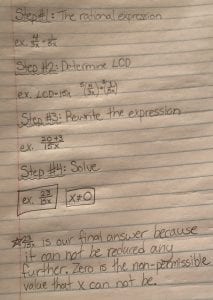This week in Pre Calc 11 we learned how to use the Sine and Cosine laws and when to use them. We learned that the Sine Law is used to determine a side or an angle of a triangle in which you couldn’t use SOH CAH TOA, a non-right triangle. Sine Law has two versions of the formula, one is used to find a missing angle and the reciprocal of the formula is used to find a missing side. The formula to find an angle is: The formula to find a missing side is:
To know which of the two formuals to use, we must remember that the variable must be in the numerator.
For example: Determine the measure of angle C.
First we must use the formula with the angles in the numerator to be able to determine angle C: Next we must eliminate the portion of the formula that does not give us any useful information:
Once we have our equation, we can finish solving for angle C:
This can be simplified to:
Next we must do the inverse sine of 80 degrees to solve for angle C. Our final answer will be:
The Cosine Law is used when you need to find a third side of a triangle, when the angle opposite to the side is given you are able to use the Cosine formula: to determine the length of the third side. We can rearrange the formula to solve for any variable, however the variable that is written on the left side of the equal side and the cosine variable must remain the same variable. Solving for a side using the Cosine Law formula is fairly straight forward, the first step is to input the information that we were given, into the formula. From there, we must solve the equation and finally square root both sides to find the final answer. We also learned that there is a second version of the Cosine Law formula that is used to determine a missing angle in a triangle:









